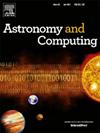Parameterized Hubble parameter with observational constraints in fractal gravity
IF 1.8
4区 物理与天体物理
Q2 ASTRONOMY & ASTROPHYSICS
引用次数: 0
Abstract
In the present paper, the dynamical aspects of the cosmological model of the Universe have been studied in fractal gravity, which is an effective quantum field theory. The parameterized Hubble parameter, given by is used to solve the field equations, where and are model parameters. We have obtained the approximate best-fit values of the model parameters using the least squares method, incorporating observational constraints from available datasets such as Hubble and Pantheon, by applying the root mean square error (RMSE) formula.
For the approximate best fit values obtained from the model parameters, we observe that the deceleration parameter exhibits a signature-flipping (transition) point within the range marking the transition from a decelerated universe to an accelerated expanding universe. In addition, we discuss various physical parameters, including pressure, energy density, and energy conditions.
分形重力观测约束下的参数化哈勃参数
本文在分形引力理论中研究了宇宙宇宙学模型的动力学方面,分形引力理论是一种有效的量子场论。参数化的哈勃参数H(z)=H02(1+(1+z)n)用于求解场方程,其中H0和n为模型参数。通过应用均方根误差(RMSE)公式,我们使用最小二乘法获得了模型参数的近似最佳拟合值,并结合了来自哈勃H(z)和万神庙等可用数据集的观测约束。对于模型参数得到的近似最佳拟合值,我们观察到减速参数q(z)在0.5≤zda≤1.668范围内有一个特征翻转(过渡)点,标志着从减速宇宙向加速膨胀宇宙过渡。此外,我们还讨论了各种物理参数,包括压力、能量密度和能量条件。
本文章由计算机程序翻译,如有差异,请以英文原文为准。
求助全文
约1分钟内获得全文
求助全文
来源期刊

Astronomy and Computing
ASTRONOMY & ASTROPHYSICSCOMPUTER SCIENCE,-COMPUTER SCIENCE, INTERDISCIPLINARY APPLICATIONS
CiteScore
4.10
自引率
8.00%
发文量
67
期刊介绍:
Astronomy and Computing is a peer-reviewed journal that focuses on the broad area between astronomy, computer science and information technology. The journal aims to publish the work of scientists and (software) engineers in all aspects of astronomical computing, including the collection, analysis, reduction, visualisation, preservation and dissemination of data, and the development of astronomical software and simulations. The journal covers applications for academic computer science techniques to astronomy, as well as novel applications of information technologies within astronomy.
 求助内容:
求助内容: 应助结果提醒方式:
应助结果提醒方式:


